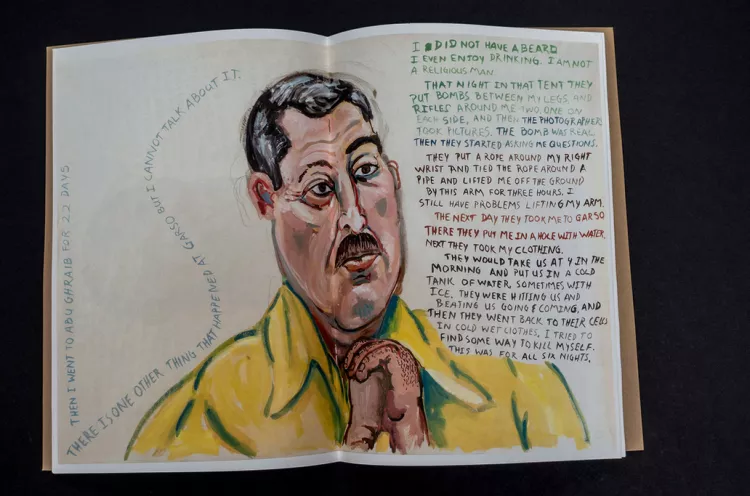Swarthmore Receives Pew Center Grant to Create, Exhibit Artists' Books

An image from Daniel Heyman’s Bearing Witness, an artist’s book about the Iraq War.
The recipient of a $300,000 grant from The Pew Center for Arts & Heritage, the College is embarking on a project to create and exhibit artists’ books that amplify personal narratives of displacement, immigration, and sanctuary.
Through Friends, Peace, and Sanctuary, Swarthmore’s libraries and the Lang Center for Civic & Social Responsibility will lift the narratives — past and present — of Iraqi and Syrian refugees to remove the sense of “otherness” and strengthen the sense of belonging.
“The project will be as rigorous as it is creative, as academic as it is artistic, as personal as it is public,” says Katie Price, the Lang Center’s assistant director for co-curricular programming and outreach, who will focus on building relationships between refugee and book arts communities and connecting the project to Swarthmore faculty, staff, and students.
“This is truly about learning with and from each other in ways that are mutually transformative,” she says.
Swarthmore is well-positioned to lead the effort, notes College Librarian Peggy Seiden, given its Quaker roots, Peace Collection, Friends Historical Library, and vast and vibrant trove of book arts. The project will both affirm and redefine libraries’ roles as collectors of knowledge and shapers of creation.
“But this project goes further by seeking to facilitate the interpretation of archival materials in light of the current refugee situation through the medium of book arts,” says Seiden, who will work closely with a curator to realize the project’s aesthetic vision, select the final book artists, and serve as a liaison between the book artists and Swarthmore’s archival collections.
“This project places us in an activist role,” she adds, “in addressing one of the most pressing social justice issues of our time.”
This is Swarthmore's second Pew Center for Arts & Heritage grant in two years, following the Chopin Without Piano project that melded classical music with contemporary theater. Friends, Peace, and Sanctuary will be be highly collaborative, too, Price notes, tapping the knowledge and experience of the Iraqi and Syrian communities in Philadelphia as well as the artistic practices of the curator and three book artists.
“The most exciting thing about the project, to me, is the ways that it brings the strengths of our Swarthmore community together with those of our local community and the international book arts community,” she says, “to think critically and creatively about the arts and social justice more broadly, and the book arts and refugee experiences more specifically.”
Working in partnership with the immigrant and refugee service organization Nationalities Service Center, Swarthmore will invite a group of refugees to work with the book artists and participate in multi-day workshops designed to provide access to new creative tools, and to explore various aspects of visual storytelling, artistic expression, and craft. Informed by these interactions and archival materials on historical refugees, the artists will then create their own unique books for a culminating exhibition in the spring of 2019.
The exhibition will cap a nearly three-year process, sparked by Director of Institutional Relations David Foreman asking Seiden if she had any ideas for projects that could be suitable for a Pew Center grant. Seiden and libraries’ staff brainstormed how to build upon the strengths of the College’s special collections before she and Foreman fine-tuned a grant proposal.
The College received notification of the grant earlier this month and is in the process of building an advisory board, to include off-campus members of the book arts community. Among the board's members are Wendy Chmielewski, curator of the Peace Collection; Syd Carpenter, professor of studio arts; Emily Paddon Rhoads, assistant professor of political science; Sa’ed Atshan '06, assistant professor of peace and conflict studies; and Nathalie Anderson, professor of English literature.
The project leaders are also looking for students to serve as translators for selected works in the Peace Collection, opening those resources up to new people and communities, and more than 40 students have expressed interest in that and other potential projects. They’re also working with faculty on ways of embedding the project into Swarthmore’s curriculum.
“This project exemplifies, in novel and concrete ways, the Lang Center’s core mission of connecting campus, curriculum, and communities,” says Price. “It will bring to the current refugee crisis the College’s and the community’s collective knowledge of migration, peace, and social justice. This is engaged scholarship at its finest.”



